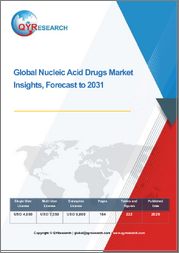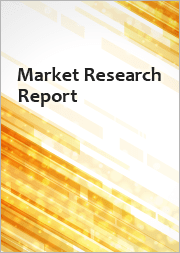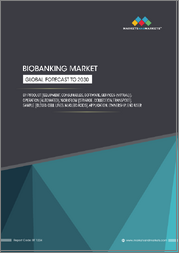
|
시장보고서
상품코드
1534168
세계의 핵산 증폭 검사(NAAT) 시장 : 시장 규모 조사 - 유형별, 용도별, 최종 용도별, 지역별 예측(2022-2032년)Global Nucleic Acid Amplification Testing Market Size study, by Type (Polymerase Chain Reaction Tests, Isothermal Nucleic Acid Amplification Technology Tests, Ligase Chain Reaction Tests), by Application, by End-use and Regional Forecasts 2022-2032 |
||||||
세계의 핵산 증폭 검사 시장은 2023년에 약 81억 9,000만 달러로 평가되었고, 예측 기간 2024년부터 2032년까지 12.2% 이상의 견실한 성장률로 성장할 것으로 예측되고 있습니다.
핵산 증폭 검사(NAAT)는 병원체나 유전물질로부터 DNA나 RNA 등의 특정 핵산 서열을 검출 및 증폭하기 위해 사용되는 분자기술입니다. 이 방법은 PCR(중합효소 연쇄반응), RT-PCR(역전사 PCR), LAMP(루프 매개 등온 증폭)를 포함합니다. NAAT는 민감하고 특이성이 높기 때문에 COVID-19, 결핵, HIV 등의 감염을 진단하는 데 유용합니다. 또한 유전자 검사, 암 검출, 법의학에도 사용되고 있습니다. NAAT는 질병의 조기 및 정확한 발견을 허용하고 적절한 치료 및 관리 전략을 이끌어 냅니다.
시장 성장의 원동력이 되는 것은 고급 신속 진단에 대한 수요의 급증과 신규 생명공학 진단 기술의 개발을 위한 연구개발 투자 증가입니다. 세계의 전염병 유행률이 높고 질병 발생을 잘 관리하기 위한 고효율 검사 대안의 필요성은 다양한 핵산 증폭 검사 기술에 대한 수요를 끌어올리고 있습니다. 특히 COVID-19는 SARS-CoV-2 바이러스를 검출하기 위한 신속하고 정확한 검사 방법에 대한 수요를 크게 증가시켰습니다. 주요 시장 기업은 신속하고 포인트 오브 케어 검사에 대한 높은 수요에 부응하기 위해 등온 핵산 증폭 기술에 기초한 검사 등의 신제품을 개발함으로써 대응하고 있습니다.
NAAT 시장을 견인하는 주요 요인으로는 감염증 유행 증가, 고급 진단 수단에 대한 수요 증가, 새로운 생명공학 진단 기술 개발에 대한 투자 증가 등이 있습니다. 그러나 숙련된 전문가 부족과 이러한 검사와 관련된 높은 비용이 시장 성장을 억제할 수 있습니다. 그럼에도 불구하고 세계 건강 관리 지출 증가와 진단 기술의 끊임없는 진보는 NAAT 시장에 큰 성장 기회를 가져왔습니다.
북미는 만성질환의 유병률이 높고, 확립된 연구 및 헬스케어 인프라가 존재하기 때문에 2023년 시장 규모는 북미가 압도적이며, 최대의 수익 점유율을 차지했습니다. 이 지역에 있어서의 핵산 증폭 검사 수요는 POC(Point of Care) 진단법이나 광범위한 질병 예방 대책에 대한 주목이 높아지고 있는 것이 배경에 있습니다. 대조적으로, 아시아태평양은 인구가 많고 건강 관리 시스템에 대한 관심이 높아짐에 따라 예측 기간 동안 가장 빠른 CAGR로 성장할 것으로 예상됩니다. 일본 뇌염, 헨드라, 니파바이러스 감염증 등 신흥 감염증의 발생률이 높기 때문에 이 지역에서의 핵산 증폭 검사 시장 전망은 강화될 가능성이 있습니다.
목차
제1장 세계의 핵산 증폭 검사 시장 주요 요약
- 세계의 핵산 증폭 검사 시장 규모 및 예측(2022-2032년)
- 지역별 개요
- 부문별 개요
- 유형별
- 용도별
- 최종 용도별
- 주요 동향
- 경기 후퇴의 영향
- 애널리스트의 결론 및 제안
제2장 세계의 핵산 증폭 검사 시장 정의 및 조사의 전제조건
- 조사 목적
- 시장의 정의
- 조사의 전제조건
- 포함과 제외
- 제한 사항
- 공급측 분석
- 가용성
- 인프라
- 규제 환경
- 시장 경쟁
- 경제성(소비자의 시점)
- 수요측 분석
- 규제 프레임워크
- 기술의 진보
- 환경에 대한 배려
- 소비자의 의식 및 수용
- 조사 방법
- 조사 대상년도
- 환율 변환율
제3장 세계의 핵산 증폭 검사 시장 역학
- 시장 성장 촉진요인
- 감염증의 유행 증가
- 생명공학 진단에 대한 투자 증가
- 진단 방법의 기술적 진보
- 시장의 과제
- 숙련된 전문가의 부족
- NAAT와 관련된 높은 비용
- 시장 기회
- 신흥 시장에서의 확대
- POC(Point of Care) 진단의 성장
- 연구개발 투자 증가
제4장 세계의 핵산 증폭 검사 시장 산업 분석
- Porter's Five Forces 모델
- 공급기업의 협상력
- 구매자의 협상력
- 신규 참가업체의 위협
- 대체품의 위협
- 경쟁 기업간 경쟁 관계
- Porter's Five Forces 모델에 대한 미래적 접근
- Porter's Five Forces의 영향 분석
- PESTEL 분석
- 정치
- 경제
- 사회
- 기술
- 환경
- 법률
- 주요 투자 기회
- 주요 성공 전략
- 파괴적 동향
- 업계 전문가의 시점
- 애널리스트의 결론 및 제안
제5장 세계의 핵산 증폭 검사 시장 규모 및 예측 : 유형별(2022-2032년)
- 부문 대시보드
- 세계의 핵산 증폭 검사 시장 : 수익 동향 분석(2022년, 2032년)
- 중합효소 연쇄반응(PCR) 검사
- 등온 핵산 증폭 기술(INAAT) 검사
- 리가제 연쇄반응(LCR) 검사
제6장 세계의 핵산 증폭 검사 시장 규모 및 예측 : 용도별(2022-2032년)
- 부문 대시보드
- 세계의 핵산 증폭 검사 시장 : 수익 동향 분석(2022년, 2032년)
- 감염증 검사
- 종양학 검사
- 유전자 및 미토콘드리아병 검사
- 기타
제7장 세계의 핵산 증폭 검사 시장 규모 및 예측 : 최종 용도별(2022-2032년)
- 부문 대시보드
- 세계의 핵산 증폭 검사 시장 : 수익 동향 분석(2022년, 2032년)
- 병원
- 중앙 및 기준 실험실
- 기타
제8장 세계의 핵산 증폭 검사 시장 규모 및 예측 : 지역별(2022-2032년)
- 북미
- 미국
- 캐나다
- 유럽
- 영국
- 독일
- 프랑스
- 스페인
- 이탈리아
- 기타 유럽
- 아시아태평양
- 중국
- 인도
- 일본
- 호주
- 한국
- 기타 아시아태평양
- 라틴아메리카
- 브라질
- 멕시코
- 기타 라틴아메리카
- 중동 및 아프리카
- 사우디아라비아
- 남아프리카
- 기타 중동 및 아프리카
제9장 경쟁 정보
- 주요 기업의 SWOT 분석
- 주요 시장 전략
- 기업 프로파일
- F. Hoffmann-La Roche Ltd
- 주요 정보
- 개요
- 재무(데이터의 이용가능성에 따름)
- 제품 개요
- 시장 전략
- Becton, Dickinson and Company
- Danaher Corporation
- Abbott Laboratories
- Illumina, Inc.
- Siemens Healthineers
- bioMerieux SA
- Novartis AG
- Bio-Rad Laboratories, Inc.
- Seegene Inc.
- F. Hoffmann-La Roche Ltd
제10장 조사 과정
- 조사 과정
- 데이터 마이닝
- 분석
- 시장 추정
- 검증
- 출판
- 조사 속성
The Global Nucleic Acid Amplification Testing Market is valued at approximately USD 8.19 billion in 2023 and is anticipated to grow with a healthy growth rate of more than 12.2% over the forecast period 2024-2032. Nucleic Acid Amplification Testing (NAAT) is a molecular technique used to detect and amplify specific nucleic acid sequences, such as DNA or RNA, from pathogens or genetic material. This method includes PCR (Polymerase Chain Reaction), RT-PCR (Reverse Transcription PCR), and LAMP (Loop-Mediated Isothermal Amplification). NAAT is highly sensitive and specific, making it valuable for diagnosing infectious diseases like COVID-19, tuberculosis, and HIV. It is also used in genetic testing, cancer detection, and forensic science. NAAT enables early and accurate detection of diseases, guiding appropriate treatment and management strategies.
The market's growth is fueled by a surge in demand for advanced rapid diagnostics and rising R&D investments in developing novel biotechnological diagnostic techniques. The high global prevalence of infectious diseases and the need for highly efficient testing alternatives to successfully manage disease outbreaks have propelled the demand for various nucleic acid amplification testing technologies. COVID-19, in particular, has significantly increased the demand for rapid and accurate testing methods to detect the SARS-CoV-2 virus. Key market players have responded by developing new product offerings, such as isothermal nucleic acid amplification technology-based tests, to meet the high demand for rapid and point-of-care testing.
The major factors driving the NAAT market include the rising prevalence of infectious diseases, increasing demand for advanced diagnostic measures, and growing investment in developing new biotechnological diagnostic techniques. However, a lack of skilled professionals and the higher costs associated with these tests may restrain the market's growth. Nonetheless, the global increase in healthcare spending and continuous advancements in diagnostic technology provide significant growth opportunities for the NAAT market.
North America dominated the market in 2023, accounting for the largest revenue share due to the high prevalence of chronic diseases and the presence of an established research and healthcare infrastructure. The demand for nucleic acid amplification tests in the region is driven by the increasing focus on point-of-care diagnostic methods and extensive disease prevention measures. In contrast, the Asia Pacific region is expected to grow at the fastest CAGR during the forecast period, driven by its large population and rising focus on healthcare systems. The high incidence of emerging infectious diseases such as Japanese encephalitis, Hendra, and Nipah virus infections can strengthen the market prospects for nucleic acid amplification testing in the region.
Major market players included in this report are:
- F. Hoffmann-La Roche Ltd
- Becton, Dickinson and Company
- Danaher Corporation
- Abbott Laboratories
- Illumina, Inc.
- Siemens Healthineers
- bioMerieux SA
- Novartis AG
- Bio-Rad Laboratories, Inc.
- Seegene Inc.
The detailed segments and sub-segment of the market are explained below:
By Type:
- Polymerase Chain Reaction (PCR) Tests
- Isothermal Nucleic Acid Amplification Technology (INAAT) Tests
- Ligase Chain Reaction (LCR) Tests
By Application:
- Infectious Disease Testing
- Oncology Testing
- Genetic & Mitochondrial Disease Testing
- Others
By End-use:
- Hospitals
- Central And Reference Laboratories
- Others
By Region:
- North America
- U.S.
- Canada
- Europe
- UK
- Germany
- France
- Spain
- Italy
- ROE
- Asia Pacific
- China
- India
- Japan
- Australia
- South Korea
- RoAPAC
- Latin America
- Brazil
- Mexico
- RoLA
- Middle East & Africa
- Saudi Arabia
- South Africa
- RoMEA
Years considered for the study are as follows:
- Historical year - 2022
- Base year - 2023
- Forecast period - 2024 to 2032
Key Takeaways:
- Market Estimates & Forecast for 10 years from 2022 to 2032.
- Annualized revenues and regional level analysis for each market segment.
- Detailed analysis of geographical landscape with Country level analysis of major regions.
- Competitive landscape with information on major players in the market.
- Analysis of key business strategies and recommendations on future market approach.
- Analysis of competitive structure of the market.
- Demand side and supply side analysis of the market.
Table of Contents
Chapter 1. Global Nucleic Acid Amplification Testing Market Executive Summary
- 1.1. Global Nucleic Acid Amplification Testing Market Size & Forecast (2022-2032)
- 1.2. Regional Summary
- 1.3. Segmental Summary
- 1.3.1. By Type
- 1.3.2. By Application
- 1.3.3. By End-use
- 1.4. Key Trends
- 1.5. Recession Impact
- 1.6. Analyst Recommendation & Conclusion
Chapter 2. Global Nucleic Acid Amplification Testing Market Definition and Research Assumptions
- 2.1. Research Objective
- 2.2. Market Definition
- 2.3. Research Assumptions
- 2.3.1. Inclusion & Exclusion
- 2.3.2. Limitations
- 2.3.3. Supply Side Analysis
- 2.3.3.1. Availability
- 2.3.3.2. Infrastructure
- 2.3.3.3. Regulatory Environment
- 2.3.3.4. Market Competition
- 2.3.3.5. Economic Viability (Consumer's Perspective)
- 2.3.4. Demand Side Analysis
- 2.3.4.1. Regulatory frameworks
- 2.3.4.2. Technological Advancements
- 2.3.4.3. Environmental Considerations
- 2.3.4.4. Consumer Awareness & Acceptance
- 2.4. Estimation Methodology
- 2.5. Years Considered for the Study
- 2.6. Currency Conversion Rates
Chapter 3. Global Nucleic Acid Amplification Testing Market Dynamics
- 3.1. Market Drivers
- 3.1.1. Increasing Prevalence of Infectious Diseases
- 3.1.2. Rising Investment in Biotechnological Diagnostics
- 3.1.3. Technological Advancements in Diagnostic Methods
- 3.2. Market Challenges
- 3.2.1. Lack of Skilled Professionals
- 3.2.2. High Costs Associated with NAAT
- 3.3. Market Opportunities
- 3.3.1. Expansion in Emerging Markets
- 3.3.2. Growth in Point-of-Care Diagnostics
- 3.3.3. Increasing R&D Investments
Chapter 4. Global Nucleic Acid Amplification Testing Market Industry Analysis
- 4.1. Porter's 5 Force Model
- 4.1.1. Bargaining Power of Suppliers
- 4.1.2. Bargaining Power of Buyers
- 4.1.3. Threat of New Entrants
- 4.1.4. Threat of Substitutes
- 4.1.5. Competitive Rivalry
- 4.1.6. Futuristic Approach to Porter's 5 Force Model
- 4.1.7. Porter's 5 Force Impact Analysis
- 4.2. PESTEL Analysis
- 4.2.1. Political
- 4.2.2. Economical
- 4.2.3. Social
- 4.2.4. Technological
- 4.2.5. Environmental
- 4.2.6. Legal
- 4.3. Top investment opportunity
- 4.4. Top winning strategies
- 4.5. Disruptive Trends
- 4.6. Industry Expert Perspective
- 4.7. Analyst Recommendation & Conclusion
Chapter 5. Global Nucleic Acid Amplification Testing Market Size & Forecasts by Type 2022-2032
- 5.1. Segment Dashboard
- 5.2. Global Nucleic Acid Amplification Testing Market: Type Revenue Trend Analysis, 2022 & 2032 (USD Billion)
- 5.2.1. Polymerase Chain Reaction (PCR) Tests
- 5.2.2. Isothermal Nucleic Acid Amplification Technology (INAAT) Tests
- 5.2.3. Ligase Chain Reaction (LCR) Tests
Chapter 6. Global Nucleic Acid Amplification Testing Market Size & Forecasts by Application 2022-2032
- 6.1. Segment Dashboard
- 6.2. Global Nucleic Acid Amplification Testing Market: Application Revenue Trend Analysis, 2022 & 2032 (USD Billion)
- 6.2.1. Infectious Disease Testing
- 6.2.2. Oncology Testing
- 6.2.3. Genetic & Mitochondrial Disease Testing
- 6.2.4. Others
Chapter 7. Global Nucleic Acid Amplification Testing Market Size & Forecasts by End-use 2022-2032
- 7.1. Segment Dashboard
- 7.2. Global Nucleic Acid Amplification Testing Market: End-use Revenue Trend Analysis, 2022 & 2032 (USD Billion)
- 7.2.1. Hospitals
- 7.2.2. Central And Reference Laboratories
- 7.2.3. Others
Chapter 8. Global Nucleic Acid Amplification Testing Market Size & Forecasts by Region 2022-2032
- 8.1. North America Nucleic Acid Amplification Testing Market
- 8.1.1. U.S. Nucleic Acid Amplification Testing Market
- 8.1.1.1. Type breakdown size & forecasts, 2022-2032
- 8.1.1.2. Application breakdown size & forecasts, 2022-2032
- 8.1.1.3. End-use breakdown size & forecasts, 2022-2032
- 8.1.2. Canada Nucleic Acid Amplification Testing Market
- 8.1.1. U.S. Nucleic Acid Amplification Testing Market
- 8.2. Europe Nucleic Acid Amplification Testing Market
- 8.2.1. U.K. Nucleic Acid Amplification Testing Market
- 8.2.2. Germany Nucleic Acid Amplification Testing Market
- 8.2.3. France Nucleic Acid Amplification Testing Market
- 8.2.4. Spain Nucleic Acid Amplification Testing Market
- 8.2.5. Italy Nucleic Acid Amplification Testing Market
- 8.2.6. Rest of Europe Nucleic Acid Amplification Testing Market
- 8.3. Asia-Pacific Nucleic Acid Amplification Testing Market
- 8.3.1. China Nucleic Acid Amplification Testing Market
- 8.3.2. India Nucleic Acid Amplification Testing Market
- 8.3.3. Japan Nucleic Acid Amplification Testing Market
- 8.3.4. Australia Nucleic Acid Amplification Testing Market
- 8.3.5. South Korea Nucleic Acid Amplification Testing Market
- 8.3.6. Rest of Asia Pacific Nucleic Acid Amplification Testing Market
- 8.4. Latin America Nucleic Acid Amplification Testing Market
- 8.4.1. Brazil Nucleic Acid Amplification Testing Market
- 8.4.2. Mexico Nucleic Acid Amplification Testing Market
- 8.4.3. Rest of Latin America Nucleic Acid Amplification Testing Market
- 8.5. Middle East & Africa Nucleic Acid Amplification Testing Market
- 8.5.1. Saudi Arabia Nucleic Acid Amplification Testing Market
- 8.5.2. South Africa Nucleic Acid Amplification Testing Market
- 8.5.3. Rest of Middle East & Africa Nucleic Acid Amplification Testing Market
Chapter 9. Competitive Intelligence
- 9.1. Key Company SWOT Analysis
- 9.2. Top Market Strategies
- 9.3. Company Profiles
- 9.3.1. F. Hoffmann-La Roche Ltd
- 9.3.1.1. Key Information
- 9.3.1.2. Overview
- 9.3.1.3. Financial (Subject to Data Availability)
- 9.3.1.4. Product Summary
- 9.3.1.5. Market Strategies
- 9.3.2. Becton, Dickinson and Company
- 9.3.3. Danaher Corporation
- 9.3.4. Abbott Laboratories
- 9.3.5. Illumina, Inc.
- 9.3.6. Siemens Healthineers
- 9.3.7. bioMerieux SA
- 9.3.8. Novartis AG
- 9.3.9. Bio-Rad Laboratories, Inc.
- 9.3.10. Seegene Inc.
- 9.3.1. F. Hoffmann-La Roche Ltd
Chapter 10. Research Process
- 10.1. Research Process
- 10.1.1. Data Mining
- 10.1.2. Analysis
- 10.1.3. Market Estimation
- 10.1.4. Validation
- 10.1.5. Publishing
- 10.2. Research Attributes

















